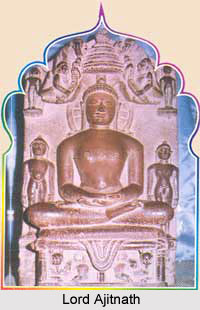 Shri 1008 Ajitnath Digambar Jain Atishaya Kshetra Bandhaji is located in Madhya Pradesh. It is an Atishaya Kshetra i.e. place of miracles. The principal deity of the temple is Lord Ajitnath, the second Jain Tirthankara.
Shri 1008 Ajitnath Digambar Jain Atishaya Kshetra Bandhaji is located in Madhya Pradesh. It is an Atishaya Kshetra i.e. place of miracles. The principal deity of the temple is Lord Ajitnath, the second Jain Tirthankara.
History of Ajitnath Digambar Jain Temple
According to history as well as historical and archaeological evidences Shri Bandhaji Atishaya Kshetra is more than 1500 years ancient. The idol of Lord Ajitnath is almost 900 years old. The place is located in the midst of natural beauty. The place had been developed during the time of Chandella Dynasty. The Bhonyare or Basement that have been constructed here dates back to the time of Muslim rulers. These were built to keep the idols safe from being destroyed at the hands of these rulers. The 7 Bhonyare are popular in `Bundelkhand` which are situated in `Pava`, `Deogarh`, `Seron`, `Karguvan`, `Bandha`, `Papora` and `Thuvon`. It is said that these 7 Basements were constructed by two brothers, `Devpat` and `Khevpat`. The two ancient spired temples are also constructed here which are worth seeing from the point of view of art and magnificence.
The temple is associated with many legends and miracles.
During the rule of the Mughal Dynasty when the idols in `Bandhaji` were being destroyed then at that time all destroyers were caught in a type of Bond. They soon realised the miraculous power of the idol. They did expiation for their deed. According to another legend once in the year 1953 Acharya Mahaveer Kirtiji visited the place. At that time there was no water in the well. As the Acharya sprinkled `Abhishek Ka Jal` i.e. water of consecration in the well, water got filled in the well. From that time onwards the water is always available in this well. Yet another legend states that devotional songs, sounds of dance and other musical instruments can be heard from the temple at night. It is also believed that in 1890 one artist from Samvat was going to `Bamhori` for selling the idols. The Bullock cart suddenly stopped near the `Big Peepal` Tree of Bamhori. Even after several efforts it refused to move. Thus the artist decided to install the idol in `Bandhaji Kshetra`. The cart started moving towards Bandhaji. The idols can be seen in huge temple of Bandhaji.
Temple of Shri Bandhaji Atishaya Kshetra
The temple of Shri Bandhaji Atishaya Kshetra dates back to the ancient period. The huge temple is 65 feet height and has been constructed in the midst of dense forest. The temple has been built is in the 18th century and is adorned with intricate architectural designs. There is also a small temple near this main temple. It is believed that this small temple was once a `Math` and later it was converted into a small temple. The temple has 12 doors in this altar. A `Dharmachakra` is created in center of this temple.
The 900 years old idol of Lord Ajitnath is installed in Bhonyara. The idol was constructed in Samvat 1199. It is black in colour and is almost 3 feet in height. It is seated in a padmasana posture. The idol is flaunted by images of Bhagwan Rishabh Dev and Lord Sambhavnath on its either side. The idols are almost 2 feet in height. These both idols were worshipped and deeply revered in Samvat 1209. The other idols of Bhagwan Adinath, Lord Sambhavnath and Lord Neminath are also installed here.
Apart from these there are many other temples located here. It is possible that more than one Bhonyara might exist here. According to a legend a rock exists in this field and when any person sits on this rock he falls ill. When some scholars narrated the incident to Acharya Mahaveer Kirti, he said that there might be a presence of one Bhonyara underneath the earth.
The temple of Shri Bandhaji Atishaya Kshetra is situated amidst the beautiful hills hence it is adorned with scenic beauty that enthrals the devotees. The temple organises an annual fair for three days from Magh Shukla to Phalguna Krishna. The fair is organized as anniversary during period when Acharya Shri sprinkled `Abhishek Jal` in the well and it was at once filled with water.
Shri Bandhaji Atishaya Kshetra is well connected to rail, road and air. From Jhansi and Tikamgarh many buses are available for Bandhaji Kshetra via Bamhori. The nearest railway station is the Jhansi Railway Station. One can reach Bandhaji from Jhansi via Bamhori on Jhansi Tikamgarh Road. Kshetra is simply 7 km ahead from Bamhori. The nearest airpoirt is at Khajuraho that is located at160 km.









